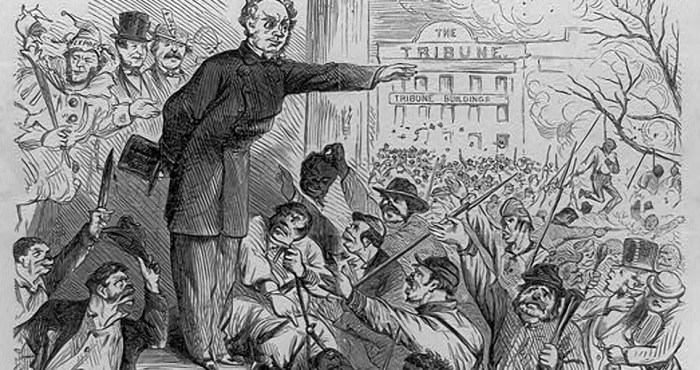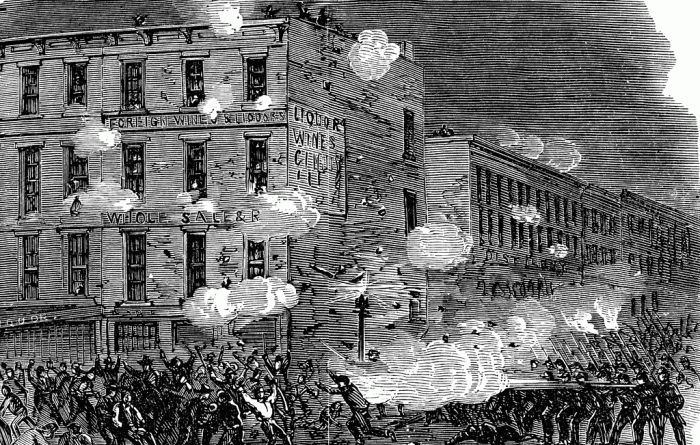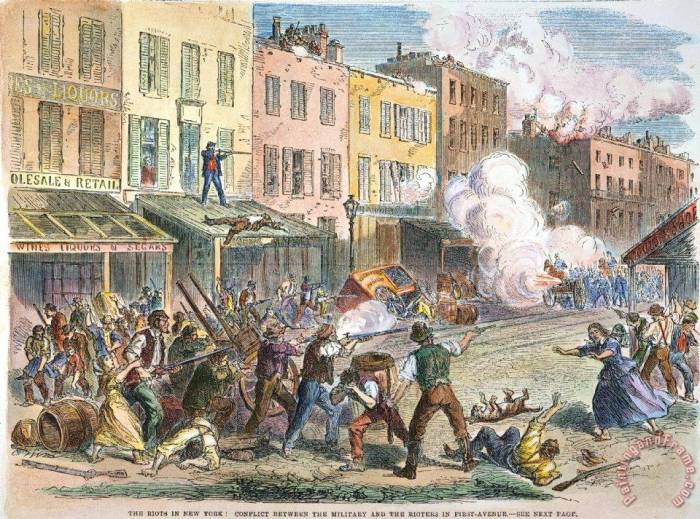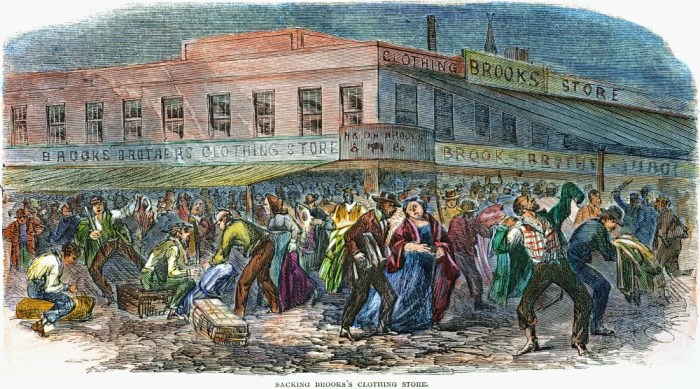The New York Draft Riots APUSH stands as a significant event in American history, a moment of unrest and violence that shook the nation. This comprehensive overview delves into the causes, course, and aftermath of these riots, providing a deeper understanding of their impact on society and the ongoing struggle for equality.
As the Civil War raged on, tensions escalated in New York City, a melting pot of social and economic disparities. The riots erupted in response to the implementation of a draft system, igniting a firestorm of racism, class conflict, and wartime tensions that would leave an enduring mark on the city’s history.
Historical Context

During the 1860s, New York City was a thriving metropolis and the largest city in the United States. It was a hub of commerce, trade, and immigration, attracting people from all over the world. However, the city was also plagued by social and economic tensions that would eventually erupt into the New York Draft Riots.
One of the most significant social tensions in New York City was the growing divide between the wealthy and the poor. The city’s economy was booming, but the benefits of that growth were not being shared equally. The rich were getting richer, while the poor were struggling to make ends meet.
This inequality led to resentment and anger among the city’s working class.
Immigration
Another major source of tension in New York City was the influx of immigrants. In the years leading up to the riots, hundreds of thousands of immigrants arrived in the city, mostly from Ireland and Germany. These immigrants often faced discrimination and prejudice from native-born Americans.
They were seen as a threat to jobs and resources, and they were often blamed for the city’s social problems.
The Draft
The final straw that led to the New York Draft Riots was the implementation of the military draft in 1863. The draft was intended to raise troops for the Union Army during the Civil War. However, many people in New York City opposed the draft, seeing it as an unfair and unjust measure.
The draft was particularly unpopular among the city’s working class, who were already struggling to make ends meet.
Causes of the Riots

The New York Draft Riots of 1863 were sparked by the implementation of the Enrollment Act, which required all able-bodied men between the ages of 20 and 45 to register for the military draft. This law was deeply unpopular among the city’s working class, who feared being forced to fight in a war they did not support.The
riots were also fueled by racism and class conflict. Many Irish immigrants, who made up a large proportion of the city’s working class, resented the fact that they were being forced to fight in a war to preserve the Union, which they saw as oppressive.
Additionally, the riots reflected the growing tensions between the city’s wealthy elite and its poor and working-class population.
Enrollment Act
The Enrollment Act was passed by Congress on March 3, 1863, as a way to increase the number of troops available to fight in the Civil War. The act required all able-bodied men between the ages of 20 and 45 to register for the draft.
Those who were drafted could either serve in the army or pay a $300 commutation fee to avoid service.The Enrollment Act was deeply unpopular among the city’s working class, who feared being forced to fight in a war they did not support.
Many Irish immigrants, who made up a large proportion of the city’s working class, resented the fact that they were being forced to fight in a war to preserve the Union, which they saw as oppressive.
Racism and Class Conflict
The New York Draft Riots were also fueled by racism and class conflict. Many Irish immigrants, who made up a large proportion of the city’s working class, resented the fact that they were being forced to fight in a war to preserve the Union, which they saw as oppressive.
Additionally, the riots reflected the growing tensions between the city’s wealthy elite and its poor and working-class population.The Irish immigrants who participated in the riots were often poor and working-class. They resented the fact that they were being forced to fight in a war that they did not believe in, and they were also angry about the discrimination they faced from the city’s wealthy elite.
The riots were a way for the Irish immigrants to express their frustration and anger, and they were also a way for them to fight back against the oppression they faced.
Comparisons to Other Urban Uprisings

The New York Draft Riots shared several similarities and differences with other major urban uprisings in American history. Some of the commonalities include widespread dissatisfaction with government policies, economic grievances, and the participation of diverse groups of people.
Similarities
- Widespread dissatisfaction with government policies: Both the Draft Riots and other urban uprisings, such as the Boston Tea Party and the Whiskey Rebellion, were sparked by dissatisfaction with government policies. In the case of the Draft Riots, it was the unpopular conscription policy that triggered the violence.
The New York Draft Riots were a turbulent period in American history, but did you know that my great-grandfather’s father is my el papá de mi abuelo es mi ? The riots were a complex event with multiple causes, but one of the main factors was the resentment of the poor and working class towards the wealthy elite.
This resentment boiled over into violence, and the city was plunged into chaos for several days.
- Economic grievances: Economic grievances were also a major factor in both the Draft Riots and other urban uprisings. The Draft Riots took place during a time of economic downturn, and many of the rioters were poor and unemployed.
- Participation of diverse groups of people: The Draft Riots, like many other urban uprisings, involved a diverse range of people, including immigrants, African Americans, and working-class whites.
Differences, New york draft riots apush
- Scale and scope: The Draft Riots were one of the largest and most destructive urban uprisings in American history. The riots lasted for several days and resulted in the deaths of over 100 people.
- Targets of violence: The targets of violence in the Draft Riots were primarily African Americans. This was in contrast to other urban uprisings, such as the Boston Tea Party, which targeted government property.
- Government response: The government response to the Draft Riots was swift and decisive. President Lincoln sent federal troops to New York City to quell the violence. This was in contrast to other urban uprisings, such as the Whiskey Rebellion, which were met with a more lenient response.
Primary Source Analysis

Examining primary sources is crucial for understanding the New York Draft Riots. These sources provide firsthand accounts and insights into the events and experiences of those involved.
To organize these primary sources, we can create a table that includes the following columns:
- Source Type
- Author
- Date
- Summary
Historiography of the Riots: New York Draft Riots Apush

The New York Draft Riots have been the subject of extensive historical research and debate, leading to the emergence of several major interpretations:
-
-*Class Conflict Interpretation
This view emphasizes the underlying class tensions and economic disparities that fueled the riots. Historians like Eric Foner argue that the riots were a class-based uprising against the wealthy elite and the perceived unfairness of the draft system.
-*Racial Conflict Interpretation
This interpretation focuses on the racial dimension of the riots, particularly the resentment and fear among white working-class Irish immigrants towards African Americans. Historians like James McPherson contend that the riots were motivated by a combination of class and racial tensions.
-*Political Manipulation Interpretation
This perspective suggests that the riots were orchestrated or manipulated by political factions, particularly the anti-war Democrats, who sought to undermine the Lincoln administration and the war effort. Historians like Adrian Cook argue that the riots were a product of political opportunism and manipulation.
Areas of Debate and Consensus
Despite these differing interpretations, there are certain areas of consensus among historians:
-
-*The riots were a complex event with multiple causes
Historians generally agree that the riots were sparked by a combination of factors, including class conflict, racial tensions, political manipulation, and wartime anxieties.
-*The riots were a significant turning point in the Civil War
The riots revealed the depth of social and political divisions within the North and forced the Lincoln administration to reassess its policies and strategies.
-*The riots left a lasting legacy of racial tension and violence
The riots exacerbated racial tensions in New York City and beyond, contributing to a pattern of discrimination and violence against African Americans that persisted for decades.
Visual Representation of the Riots

The New York Draft Riots were a tumultuous event that left a lasting impact on the city. Visual representations of the riots provide a glimpse into the chaos and destruction that unfolded during those fateful days.
Images of the Riots
- Image 1:A mob of rioters gathers in the streets, armed with clubs and bricks. This image captures the raw anger and violence that fueled the riots.
- Image 2:A burning building illuminates the night sky, casting an eerie glow over the riot-torn city. This image symbolizes the widespread destruction and loss of life that occurred during the riots.
- Image 3:A group of rioters attack a Black man, highlighting the racial tensions that played a role in the riots. This image serves as a reminder of the underlying racism that fueled the violence.
- Image 4:A group of soldiers confront the rioters, attempting to restore order. This image reflects the government’s efforts to quell the violence and maintain control.
- Image 5:A group of African Americans gather in the aftermath of the riots, expressing their anger and frustration. This image shows the lasting impact the riots had on the city’s Black community.
Key Questions Answered
What sparked the New York Draft Riots?
The riots were triggered by the implementation of a draft system to raise troops for the Union Army during the Civil War.
Who were the primary targets of the rioters?
The rioters primarily targeted African Americans, draft officials, and property associated with the abolitionist movement.
What was the extent of the damage caused by the riots?
The riots resulted in widespread destruction, including the burning of buildings, looting of businesses, and the deaths of over 100 people.